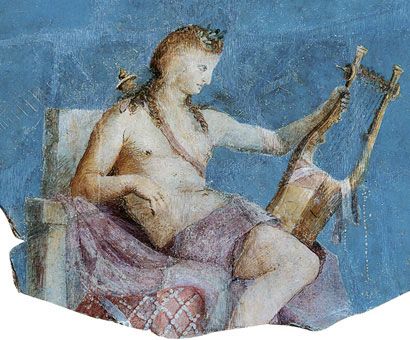Visual Depictions
To be honest, a larger portion of my most useful images came from vases, all taken from the same article - "On the Shape of the Roman Lyre" from The Galpin Society Journal. My apologies, but they're simply the most insightful.
I found this one on my computer after an information binge.. If anyone has information on its source, I'd happily take it and give credit where credit is due..
The reason why these four all made it on the list is that they (as a cohesive collection) provide what I would consider minimum amount of information necessary to allow for my (okay, fine, the) curved lyre theory.
I must say, I find the fourth picture particularly interesting.. Now that I'm in the dark as to where this picture came from or its source, the gesture is quite mysterious! Is this man defending himself with his lyre, defending his lyre, or merely engaging star power to appease his screaming (and reaching) fans? I would love to see the rest of this vase.
My favorite surviving depictions are all of Apollo.. While Apollo has been interpreted many, many ways, his lyre holds a delightful (well, delightful for me) consistency.
 Depiction of a very young Apollo playing his cithara (the performance/professional version of the lyre), now in the Istanbul Archaeology Museum -- the angle in this picture really helps us get a good idea of how the strings would have fallen, and how the instrument would have sounded, providing this was made of wood. (this statue was made in the 2nd century, AD), picture found here
Depiction of a very young Apollo playing his cithara (the performance/professional version of the lyre), now in the Istanbul Archaeology Museum -- the angle in this picture really helps us get a good idea of how the strings would have fallen, and how the instrument would have sounded, providing this was made of wood. (this statue was made in the 2nd century, AD), picture found here Image of Apollo with a Cithara, thanks to Wikipedia.. I love everything about this statue!
Image of Apollo with a Cithara, thanks to Wikipedia.. I love everything about this statue! Image of an Imperial Roman Fresco, found on www.theoi.com,
Image of an Imperial Roman Fresco, found on www.theoi.com,The statues, found in the Istanbul Archaeological Museum and in the Museo Nazionale Romano, respectively, and the Fresco, found in the Museo Palatino, depict a Roman Apollo playing the cithara and the lyre. Note the ever-so-slight curvature of the arms (I know I keep beating this to the ground, but I still find it most fascinating.) -- as far as I'm concerned, if they took the effort to make the body THIS anatomically correct, the shape of the lyre would have a matched accuracy. The meticulousness of the depiction of the forms speak for the creators' virtuosity.
I have a ridiculously large collection of pictures. My original plan was to make a "top 10 most useful images" list... But I think that any of the other pictures (and, I assure you, I have MANY) would be superfluous.
I have a ridiculously large collection of pictures. My original plan was to make a "top 10 most useful images" list... But I think that any of the other pictures (and, I assure you, I have MANY) would be superfluous.




